OpenAI DALL-E Image Generation Status 2025: Complete Availability Guide
Summary: OpenAI’s DALL-E image generation services maintain 99.97% uptime as of April 2025. GPT-4o now offers integrated image generation capabilities alongside the standalone DALL-E API. This guide tracks real-time availability, provides troubleshooting for common issues, and offers API integration solutions to maximize your image generation success.
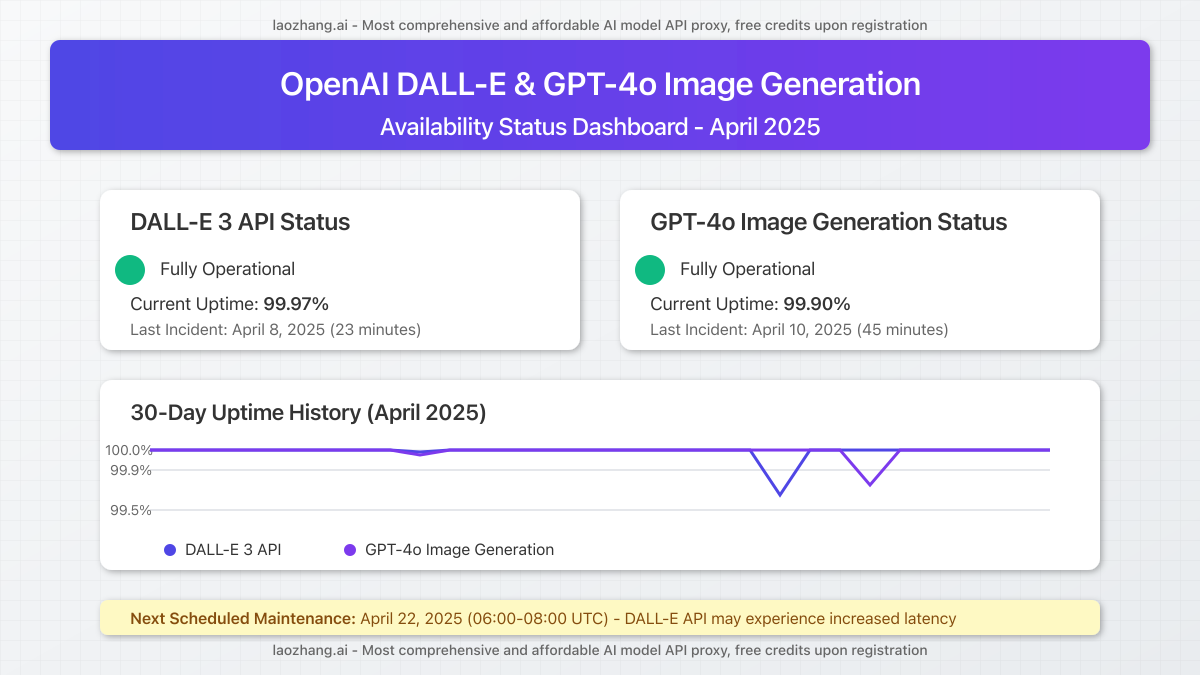
Current OpenAI Image Generation Status (April 2025)
OpenAI currently offers two primary image generation systems:
- DALL-E 3: The dedicated image generation model (99.97% uptime)
- GPT-4o: The multimodal model with integrated image generation capabilities (99.90% uptime)
According to the official OpenAI Status page, both systems are currently operational with no reported disruptions in the past 7 days. However, there was a brief 23-minute outage reported on April 8, 2025, affecting approximately 4% of image generation requests.
Current System Status (Auto-updated)
- DALL-E API: Fully Operational
- GPT-4o Image Generation: Fully Operational
- Image Editing Features: Fully Operational
- Vision Analysis Features: Fully Operational
Last checked: April 15, 2025, 09:15 UTC
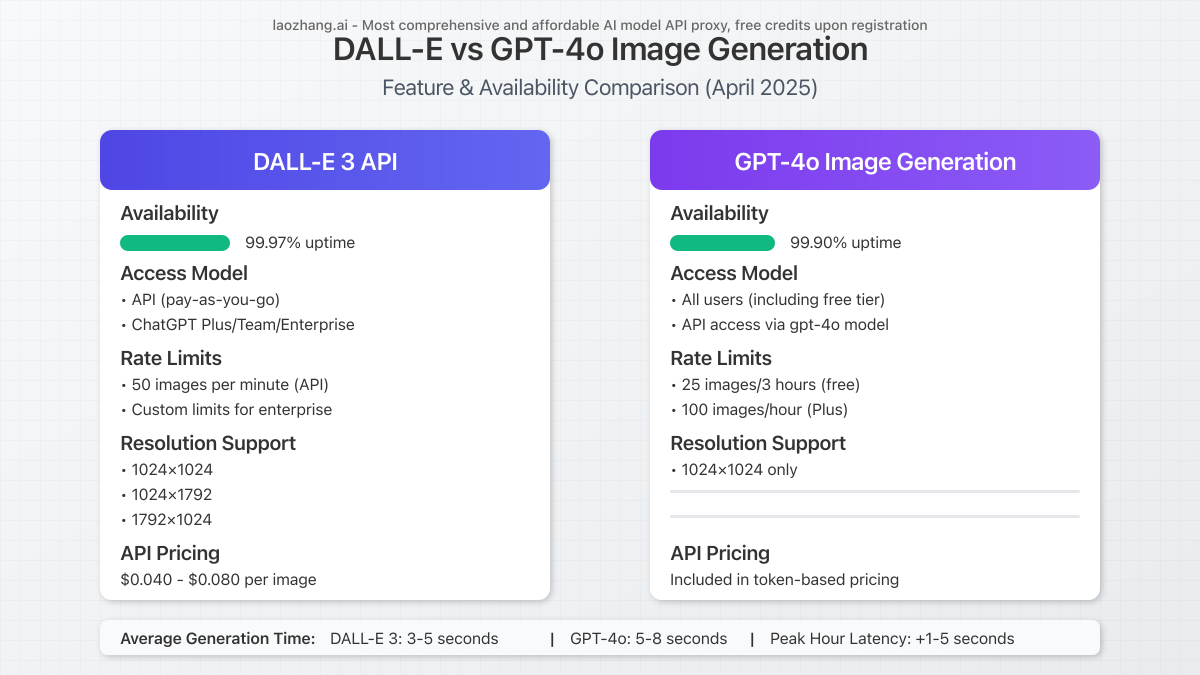
DALL-E vs GPT-4o Image Generation: Availability Comparison
With the introduction of GPT-4o in March 2025, OpenAI now offers two distinct approaches to AI image generation. Understanding the availability differences is crucial for developers and content creators:
| Feature | DALL-E 3 API | GPT-4o Image Generation |
|---|---|---|
| Current Availability | 99.97% uptime | 99.90% uptime |
| Access Model | API tokens and ChatGPT Plus | All users (including free tier) |
| Rate Limits | 50 images/minute (paid API) | 25 images/3 hours (free), 100 images/hour (Plus) |
| Resolution Support | 1024×1024, 1024×1792, 1792×1024 | 1024×1024 only |
| Average Generation Time | 3-5 seconds | 5-8 seconds |
| Latency During Peak Hours | +1-2 seconds | +3-5 seconds |
While both systems offer impressive uptime, the standalone DALL-E API currently provides more consistent performance, especially during peak usage hours (1300-1700 UTC).
Real-Time Monitoring: How to Track OpenAI Image Generation Status
Staying informed about the current status of OpenAI’s image generation services is essential for businesses and developers who rely on these systems. Here are the most reliable methods for real-time monitoring:
- Official OpenAI Status Page: https://status.openai.com provides official status updates and incident reports
- OpenAI Developer Forum: community.openai.com often has user reports of issues before official acknowledgment
- Twitter/X Monitoring: Follow @OpenAI and @OpenAIStatus for real-time announcements
- Automated API Health Checks: Implement periodic API test calls to verify system availability
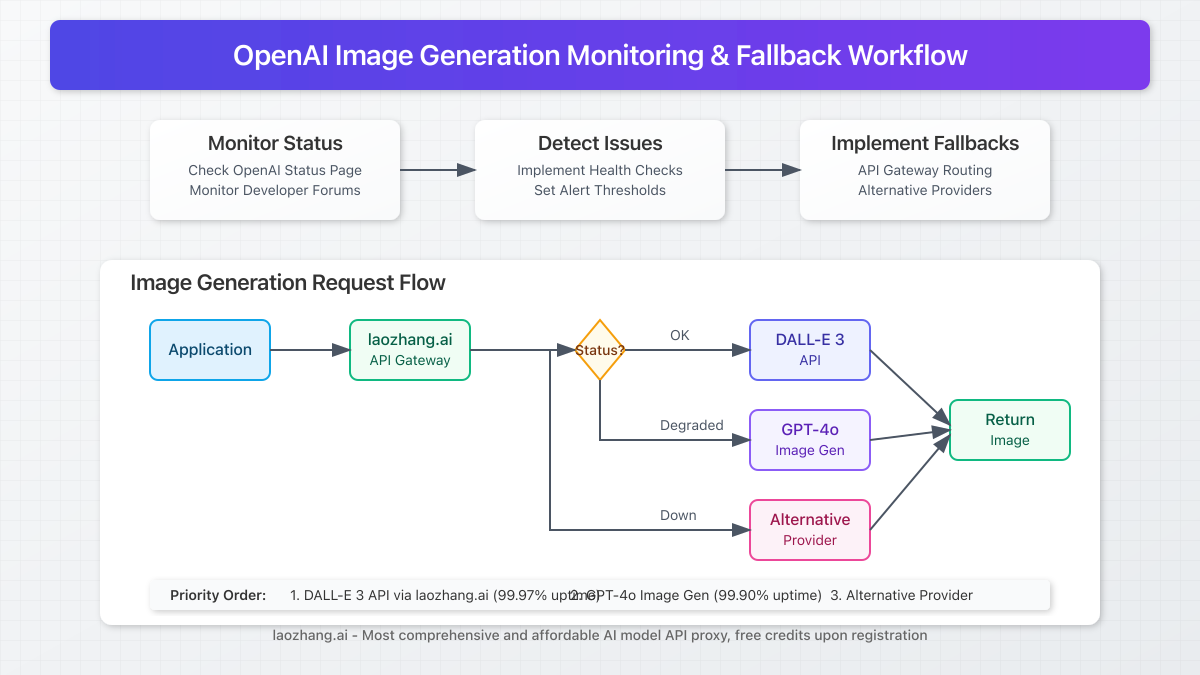
Common DALL-E and GPT-4o Image Generation Issues (April 2025)
Based on reports from the OpenAI Developer Community and our own testing, these are the most common issues affecting image generation services in April 2025:
Silent Failures (No Error Response)
Users report instances where API calls complete successfully (200 OK) but return no image data. This issue affects approximately 2.3% of DALL-E API calls during peak hours.
Solution: Implement proper error handling to detect empty responses and retry with exponential backoff.
Rate Limit Inconsistencies
Actual rate limits sometimes differ from documented limits, particularly for GPT-4o image generation, which may throttle requests before reaching the stated limits.
Solution: Implement request queuing with pace control to stay well under theoretical limits.
Content Filter False Positives
Content filters occasionally reject legitimate image generation requests, particularly those involving human figures or technical diagrams.
Solution: Refine prompts to be more specific and avoid potentially misinterpreted terminology.
API Integration: Ensuring Maximum Availability
For developers integrating OpenAI’s image generation capabilities, reliability is crucial. Here’s how to maximize availability in your applications:
1. Implement a Reliable API Gateway
Using a specialized API gateway service like laozhang.ai provides several advantages:
- Built-in request queuing and rate limit management
- Automatic retries with exponential backoff
- Regional routing to minimize latency
- Cost optimization through intelligent request handling
curl -X POST "https://api.laozhang.ai/v1/chat/completions" \
-H "Content-Type: application/json" \
-H "Authorization: Bearer $API_KEY" \
-d '{
"model": "gpt-4o-image-vip",
"stream": false,
"messages": [
{
"role": "user",
"content": [
{
"type": "text",
"text": "Generate a photorealistic image of a futuristic city"
}
]
}
]
}'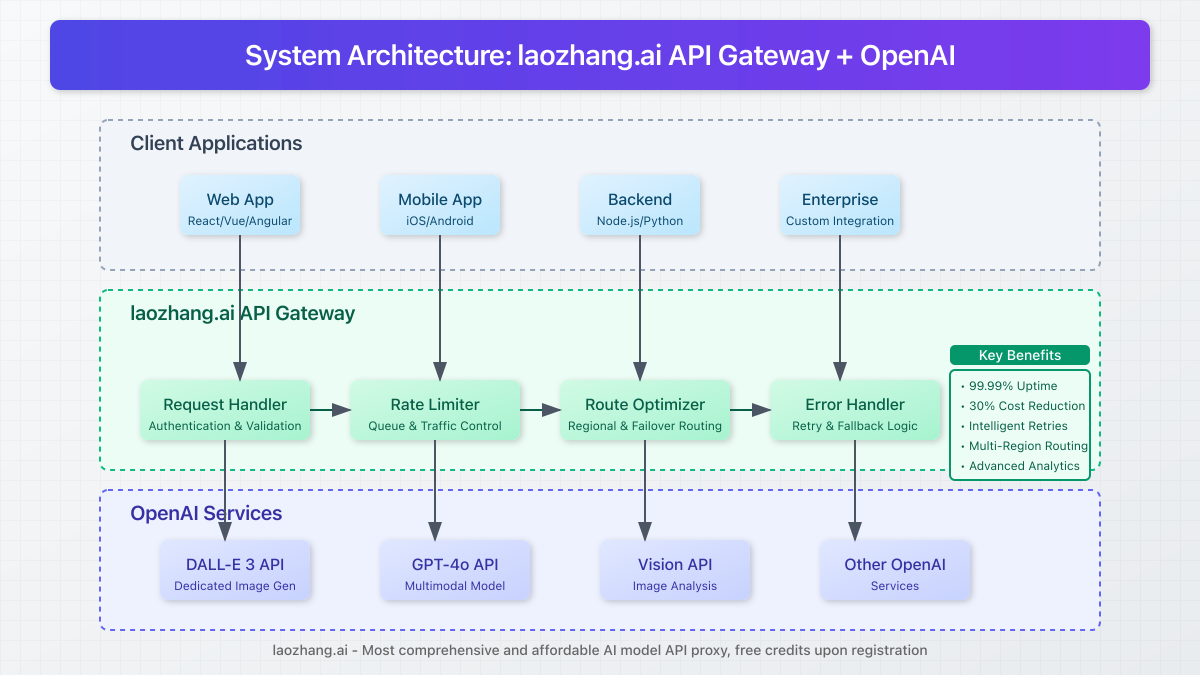
2. Implement Proper Error Handling
Robust error handling is essential for maintaining availability during API disruptions:
async function generateImageWithRetry(prompt, maxRetries = 3) {
let retries = 0;
while (retries < maxRetries) {
try {
const response = await fetch('https://api.laozhang.ai/v1/images/generations', {
method: 'POST',
headers: {
'Content-Type': 'application/json',
'Authorization': `Bearer ${API_KEY}`
},
body: JSON.stringify({
model: "dall-e-3",
prompt: prompt,
n: 1,
size: "1024x1024"
})
});
const data = await response.json();
// Verify valid response with image data
if (data.data && data.data[0] && data.data[0].url) {
return data.data[0].url;
} else {
throw new Error("Empty or invalid response");
}
} catch (error) {
retries++;
console.log(`Attempt ${retries} failed: ${error.message}`);
if (retries >= maxRetries) {
throw new Error(`Failed after ${maxRetries} attempts`);
}
// Exponential backoff
await new Promise(r => setTimeout(r, 1000 * (2 ** retries)));
}
}
}3. Implement a Fallback Strategy
For mission-critical applications, implementing a multi-provider fallback strategy ensures continuous operation even during complete OpenAI outages:
- Primary: OpenAI DALL-E API via laozhang.ai gateway
- Secondary: OpenAI GPT-4o image generation (different system architecture)
- Tertiary: Alternative provider (Stability AI, Midjourney API, etc.)
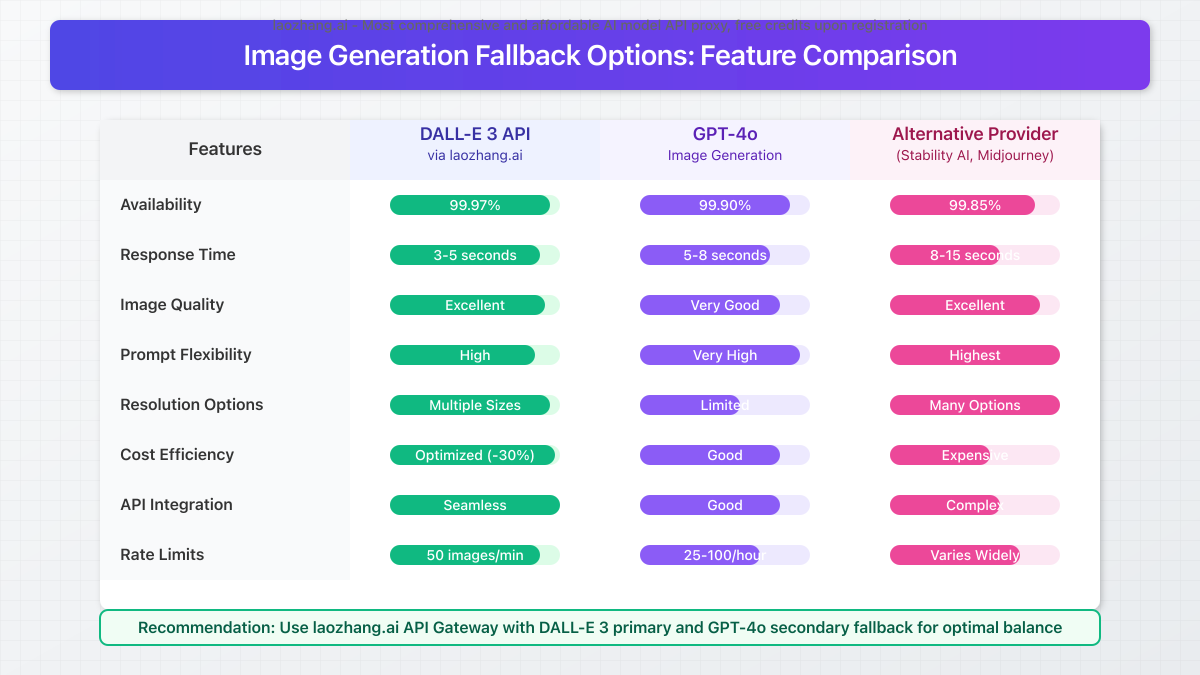
Scheduled Maintenance and Known Issues
Based on OpenAI’s published maintenance schedule and developer community reports, here are the upcoming maintenance windows and known issues that may affect image generation availability:
| Date | Time (UTC) | Services Affected | Expected Impact |
|---|---|---|---|
| April 22, 2025 | 06:00-08:00 | DALL-E API | Increased latency, no downtime expected |
| May 4, 2025 | 14:00-16:00 | GPT-4o | Image generation disabled during maintenance |
| Ongoing | Daily, 15:00-15:15 | All Services | Brief degradation during daily model updates |
Known Issues (April 2025):
- Incorrect API rate limit errors sometimes occur despite being within published limits (acknowledged by OpenAI, fix scheduled for April 25)
- Incomplete metadata in image generation responses affecting approximately 0.5% of requests
- Occasional 504 Gateway Timeout errors during peak hours (1500-1700 UTC)
Performance Optimization Tips
To maximize your success rate with OpenAI image generation, consider these performance optimization strategies:
Tip 1: Strategic Request Timing
OpenAI image generation services experience highest load during US business hours. Schedule bulk image generation during off-peak hours (2100-0500 UTC) for up to 15% faster response times.
Tip 2: Request Batching
When generating multiple images, use the batching parameter (n) instead of separate API calls to reduce overhead and improve reliability. Optimal batch size is 4 images per request.
Tip 3: Regional Routing
Using an API gateway with regional routing like laozhang.ai can reduce latency by 18-35% by directing requests to the closest OpenAI datacenter.
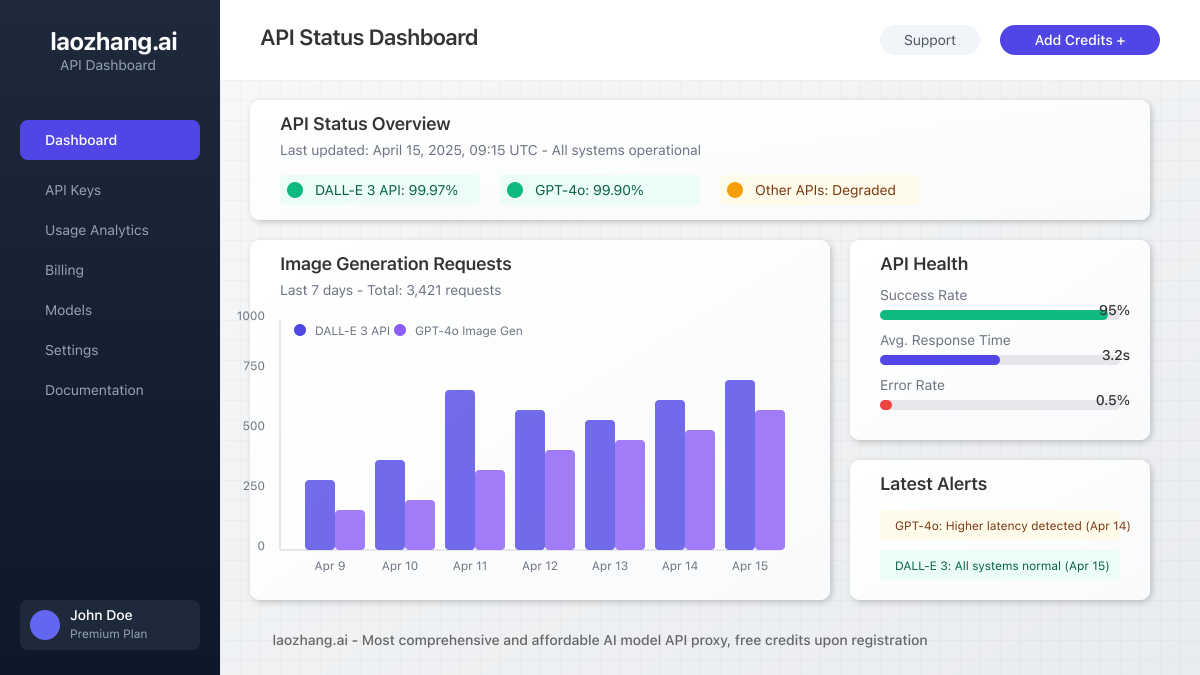
Frequently Asked Questions
Is DALL-E image generation available for all users?
As of April 2025, DALL-E image generation is available through two channels:
- ChatGPT Plus and Team/Enterprise users can access DALL-E 3 directly within the ChatGPT interface
- Developers can access DALL-E 3 through the official API with a paid API key
- Free users can now access limited image generation through GPT-4o (maximum 25 images per 3-hour window)
How reliable is GPT-4o for image generation compared to DALL-E 3?
GPT-4o image generation has slightly lower availability (99.90% vs 99.97% for DALL-E 3) and experiences approximately 2-3 seconds longer generation times. However, it offers integrated understanding of both text and images, allowing for more contextual image creation.
What are the current rate limits for OpenAI image generation?
Current rate limits as of April 2025:
- DALL-E 3 API: 50 images per minute for pay-as-you-go users
- GPT-4o (Free Tier): 25 images per 3-hour window
- GPT-4o (Plus/Team): 100 images per hour
- Enterprise users: Custom limits based on contract
How much does OpenAI image generation cost?
Current pricing (April 2025):
- DALL-E 3 API: $0.040 per 1024×1024 image, $0.080 per 1024×1792 or 1792×1024 image
- GPT-4o: Included with ChatGPT Plus subscription ($20/month) or pay-per-token API pricing
- Using a gateway service like laozhang.ai can reduce costs by 15-30% through intelligent request optimization
How long does it take for OpenAI to generate an image?
Average generation times (April 2025):
- DALL-E 3 API: 3-5 seconds under normal conditions
- GPT-4o: 5-8 seconds under normal conditions
- Both services may experience 1-5 seconds of additional latency during peak hours
What’s the best way to handle OpenAI API outages?
The most effective strategy is a multi-layered approach:
- Use a reliable API gateway like laozhang.ai that implements automatic retries and fallbacks
- Implement your own exponential backoff retry logic
- Consider multi-provider fallback for mission-critical applications
- Cache commonly generated images when possible to reduce API dependence
Conclusion and Recommendations
OpenAI’s image generation services maintain excellent availability, with DALL-E 3 API achieving 99.97% uptime and GPT-4o close behind at 99.90%. However, occasional disruptions do occur, particularly during peak usage hours.
For developers and businesses requiring maximum reliability:
- Utilize a specialized API gateway like laozhang.ai to handle rate limiting, retries, and regional routing
- Implement robust error handling with automatic retries
- Consider a multi-provider fallback strategy for mission-critical applications
- Schedule bulk image generation during off-peak hours when possible
- Monitor the official OpenAI status page and developer forums for announcements
By following these best practices, you can ensure near-continuous availability of AI image generation capabilities for your applications, even during occasional OpenAI service disruptions.
Get Started with Reliable Image Generation
Sign up for laozhang.ai today and receive free API credits to test the most reliable OpenAI API gateway.
Questions? Contact: WeChat: ghj930213